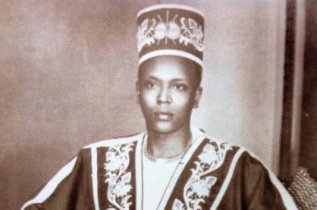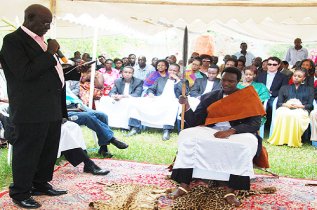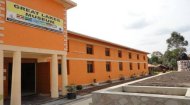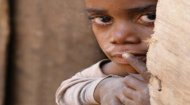Nkore History
 Cont/... The Nkore (Ankole) kingdom continued to survive in ceremonial form under British and then independent rule until formally abolished in 1967 by President Milton Obote. The last Omugabe (23rd) of the dynasty was Gasyonga II (right), who ruled between 1944-1967 but was then forced to abdicate when the role was abolished as part of the new constitution of the Republic of Uganda.
Cont/... The Nkore (Ankole) kingdom continued to survive in ceremonial form under British and then independent rule until formally abolished in 1967 by President Milton Obote. The last Omugabe (23rd) of the dynasty was Gasyonga II (right), who ruled between 1944-1967 but was then forced to abdicate when the role was abolished as part of the new constitution of the Republic of Uganda.
After an interregnum lasting until 1993, during which time Gasyonga II died in 1982, his son John Patrick Barigye was coronated as Ntare VI on 20th November 1993; however, this coronation was nullified by the Ugandan government on 4th December 1993.
Natare IV died on 14th October 2011 and was succeeded by his second son, Charles Aryaija Rwebishengye (below), from his second marriage, who was a Social Work and Social Administration (SWASA) student of Uganda Christian University in Mukono district. As with his father, he does not rule, as the kingdom was never restored by President Museveni in 1993 under the Traditional Rulers (Restitution of Assets and Properties) Statute, which saw the other kingdoms that constitute modern-day Uganda restored. Despite this, he has publicly pledged to work towards the restoration of the Ankole Kingdom, an effort his father had also pursued.
Some believe that Ankole was not because Museveni is from the area and didn't want to see two competing "rulers" not just for power but for local support although just a likely is that it was politically considered that any restoration may lead to a revival of competing Bahima (pastoralists) and Bairu (agriculturalists) caste-like historical tensions with the Bahima (believed to have originally arrived as a nomadic people from the Bahr el Ghazal area of today's South Sudan) acting as superior, symbolised by their exclusive ownership of cattle and later promoted by the visiting Europeans as such to the local Bairu who today make up a large majority of the population.
 Modern day Ntumgao was created in 1993 from the two districts of Bushenyi and Mbarara, the three counties of Kajara, Rushenyi and Ruhaama plus the part of Rwampra county which together formed the Ntungamo district boundaries. In the last decade, the town of Ntungamo itself has almost doubled in population, and today it's probably one of the better-known towns in south-west Uganda.
Modern day Ntumgao was created in 1993 from the two districts of Bushenyi and Mbarara, the three counties of Kajara, Rushenyi and Ruhaama plus the part of Rwampra county which together formed the Ntungamo district boundaries. In the last decade, the town of Ntungamo itself has almost doubled in population, and today it's probably one of the better-known towns in south-west Uganda.
The town and district also have some "favourite children" from Janet Keinembabazi Kataaha Museveni, the president's wife; Maj Gen Mugisha Muntu, the President of the Alliance for National Transformation (ANT),; Justice Richard Buteera who is currently a justice of High Court of Uganda and, of course, President Museveni himself who was born in Ntungamo on 15th August 1944.
In 2014, a museum opened in Ntungamo district exploring the history of the area. Named the "Great Lakes Museum" (see link below), its aim is "to protect the rich heritage of the area for the benefit of the young generation and for tourism." It's well worth a visit especially for the outdoor artwork installations, and the cafe's pretty good as well!
For more about life in Ntungamo today, check out the Lighthouse Project book below, a great insight into life in the town and its surrounding villages and the only book in the world to take place around Ntungamo itself. Well worth a read if you're interested in the area as it also explores Lake Nyabihoko and provides insights into local culture and provides political insights as well as interactions between local Ntungamo townfolk and 'muzungo' visitors to the area.
Page I Page II

 Cont/... The Nkore (Ankole) kingdom continued to survive in ceremonial form under British and then independent rule until formally abolished in 1967 by President Milton Obote. The last Omugabe (23rd) of the dynasty was Gasyonga II (right), who ruled between 1944-1967 but was then forced to abdicate when the role was abolished as part of the new constitution of the Republic of Uganda.
Cont/... The Nkore (Ankole) kingdom continued to survive in ceremonial form under British and then independent rule until formally abolished in 1967 by President Milton Obote. The last Omugabe (23rd) of the dynasty was Gasyonga II (right), who ruled between 1944-1967 but was then forced to abdicate when the role was abolished as part of the new constitution of the Republic of Uganda. Modern day Ntumgao was created in 1993 from the two districts of Bushenyi and Mbarara, the three counties of Kajara, Rushenyi and Ruhaama plus the part of Rwampra county which together formed the Ntungamo district boundaries. In the last decade, the town of Ntungamo itself has almost doubled in population, and today it's probably one of the better-known towns in south-west Uganda.
Modern day Ntumgao was created in 1993 from the two districts of Bushenyi and Mbarara, the three counties of Kajara, Rushenyi and Ruhaama plus the part of Rwampra county which together formed the Ntungamo district boundaries. In the last decade, the town of Ntungamo itself has almost doubled in population, and today it's probably one of the better-known towns in south-west Uganda._kingdom.jpg)




 Did you know that it been planned to build a railway station at Ntungamo (see proposed station, right) as party of a wider plan for the British to oversee construction of a railway from Egypt through their colonies down to South Africa. The costly plans were shelved, however, when Egypt declared its independence from the United Kingdom, cutting off the proposed start of the route on the Mediterranean and therefore making the project unviable. Instead, a line was constructed from Kilindini Harbour, Mombasa, into Uganda, but the wider plans never materialised.
Did you know that it been planned to build a railway station at Ntungamo (see proposed station, right) as party of a wider plan for the British to oversee construction of a railway from Egypt through their colonies down to South Africa. The costly plans were shelved, however, when Egypt declared its independence from the United Kingdom, cutting off the proposed start of the route on the Mediterranean and therefore making the project unviable. Instead, a line was constructed from Kilindini Harbour, Mombasa, into Uganda, but the wider plans never materialised.


